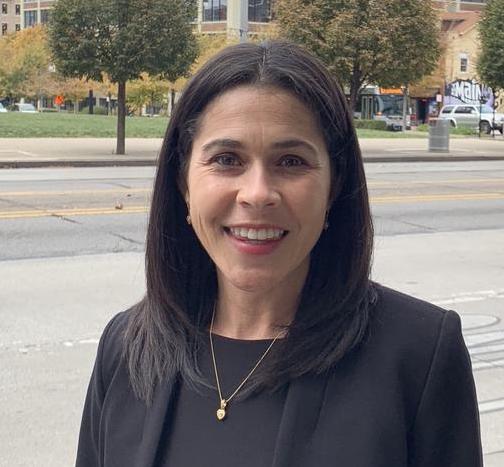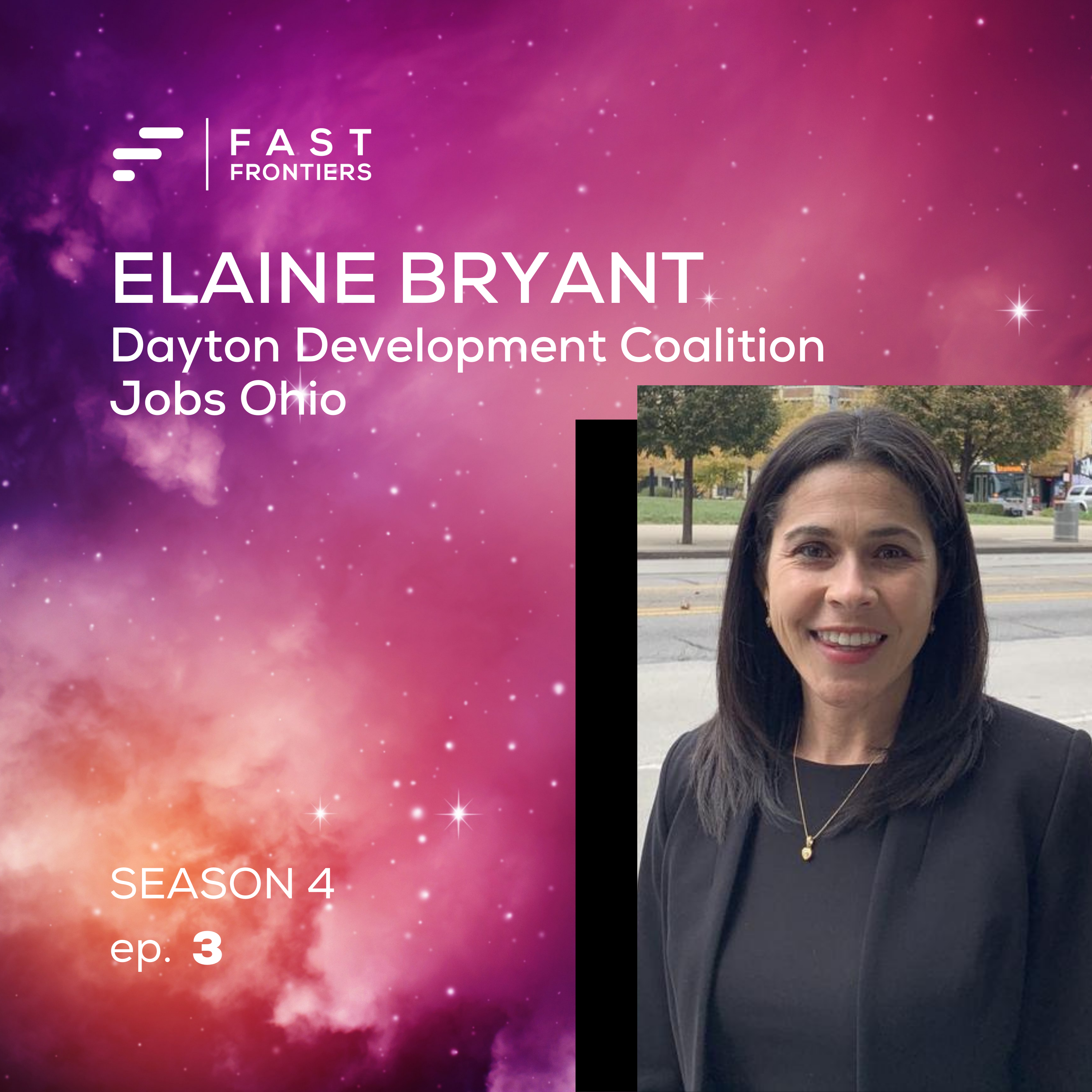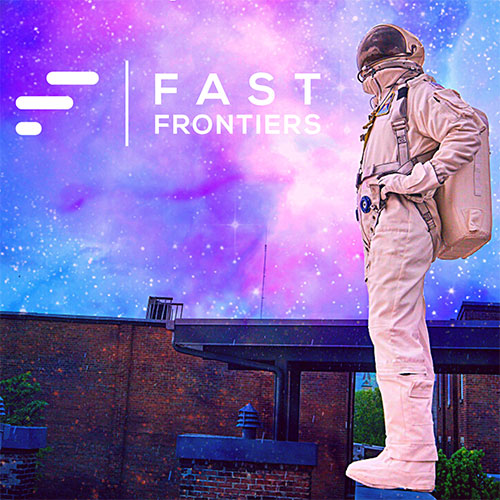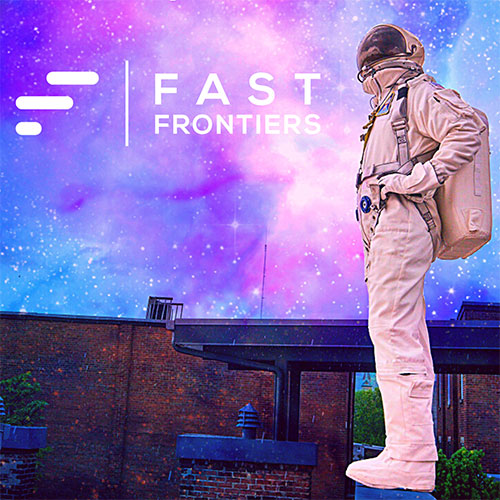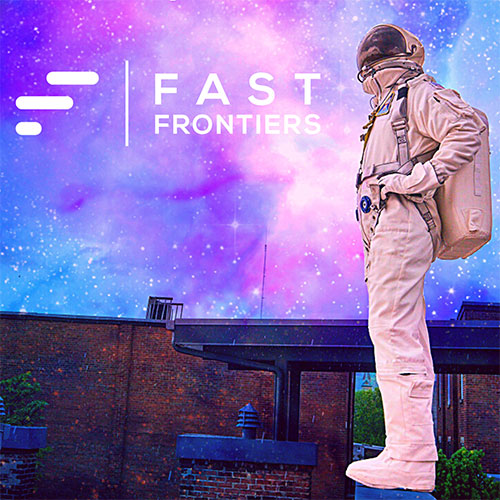S4 Ep 3. Elaine Bryant: Dayton Development Coalition & Jobs Ohio
- 0.5
- 1
- 1.25
- 1.5
- 1.75
- 2
Tim Schigel: Welcome to Fast Frontiers. I am your host, Tim Schigel, managing partner of Refinery Ventures. In this episode, we're talking to Elaine Bryant. Elaine is a 20-year Air Force veteran and currently holds dual appointments as executive vice president for Aerospace and Defense at the Dayton Development Coalition and managing director for the Military and Federal Installation Sector at JobsOhio. In this episode, we're going to dive into how economic development activity relates to the military, as well as research and initiatives like the Air Force Research Lab, which are a treasure trove of uncommercialized technologies. The biggest theme or so what I hope you take away from this episode is that there is so much innovation available, you just need to know where to look. Our military has invested countless dollars in technology. There's so much to discover and cultivate in our own backyard, so let's go window shopping. Please enjoy my conversation with Elaine Bryant. Elaine, it is so good to have you today. Welcome to Fast Frontiers.
Elaine Bryant: Thank you so much, Tim. It's great to be with you.
Tim Schigel: This is very exciting. I think people are going to learn a lot and I think probably be surprised by some of the capabilities that we have in the region and what you represent, and the fact that you're here to help us navigate that. So first, let's get into a little bit of definitional. Can you describe what it is that you're leading in terms of the Dayton Development Coalition and what your role is and why you're there?
Elaine Bryant: Well, the Dayton Development Coalition is, one, a great place to work and, B, because I get to use a lot of my background as a 20-year Air Force vet to help with economic development. So Dayton Development Coalition is a non-profit economic development for the 14 county region here in Dayton. We are one of six network partners with JobsOhio, which is the state's economic development entity. The proceeds from the liquor industry is what funds JobsOhio, so keep drinking up those spirituous liquors. And we use that partnership to help businesses grow in our state and also to help attract new companies and industries to the state. And so, here at the Dayton Development Coalition, I'm the executive vice-president for Aerospace and Defense. And as I mentioned as a 20-year Air Force veteran, it's super exciting because my focus area is on the military side, the defense applications, and all the work being done specifically at Wright-Patterson Air Force Base, home of the Life Cycle Management Center and the Air Force Research Lab, and many other organizations such as NASIC. I've worked in all of those, and it's just really fun to be able to partner that private side with the defense side in order to help accomplish our national security objectives. So people wonder, well, how does economic development relate to the military? How can you bring those two together? Well, the industries, the companies, the partners outside of Wright-Patterson Air Force Base, and frankly across the country right in the world, all those industry partners are the ones that actually help to accomplish the mission that is being directed by the Department of Defense. And so, I tell folks I live and breathe at Wright-Patterson Air Force Base, and just anything to help continuing to grow that mission. I will also add that as of March of 2020, I'm also dual-hatted. So I'm also the managing director for the Military and Federal Installation Sector at JobsOhio. So what I do here regionally in the Dayton region, I also do statewide. And the synergy with that is what helps the Dayton region helps the state, and what helps the state also helps the Dayton region. I'll just give you one nugget right now, working on a cyberspace swing in Mansfield, Ohio. So again, that's outside of my DDC region, but I'm working across the state to do what I do for Wright-Patt for all of our military installations and also for NASA.
Tim Schigel: I mean, between everything that's around Wright-Patt and the supply chains, as you mentioned, all the other partners and then down through the corridor down to GE aircraft engines in Cincinnati, the scale and amount of talent and capabilities would probably surprise people. Can you share any off-hand, kind of just some stats in terms of the size and scope of what goes on in terms of people or dollars or companies?
Elaine Bryant: Absolutely. So the talent here in Dayton and frankly in the state, as we're looking at a new information wing in Mansfield, looking at the numbers of the talent, the students that are graduating with the STEM degrees, with the right certifications, it's really impressive and to see how we compare against the other states is quite impressive. I don't have any exact numbers off the top of my head here. We can probably chat about those at a later date. But we do have the talent, and that talent is coming from various places, right? Our university system is just phenomenal. Actually working with Scott Petersen from UC here earlier this morning, he's leading Digital Futures down there at the University of Cincinnati. That's creating a pipeline of students that have been working on real applications. These aren't just made up by professor projects for the students. They are real applications and things that are going to be delivered to the army, to the DOD. So Digital Futures is doing an amazing job with that out of Cincinnati. And then, that pipeline of students, what we want to do is we want to show them all the opportunities that are here in Ohio, whether it is working somewhere on Wright- Patt or if it's working for one of those companies, industry partners, or those new entrepreneurial ventures that are standing up to support those needs. So that's really exciting. And UC is definitely a key player there as some of the other universities in our region.
Tim Schigel: I remember in a meeting I had up at Wright-Patt a few years ago with AFRL, Air Force Research Labs, which is headquartered there, right, and the number was something on the order of $300 million a year in research. So you think of the major research universities, but didn't necessarily realize that AFRL right there had $300 million a year. And the next surprising thing was they were very interested in commercialization. They were very aware that there's a lot of technology that they develop, fundamental technology, that could be applied commercially and they're very interested in seeing that happen. However, it still hasn't been happening nearly to the extent that it could be. So it's amazing. As an entrepreneur, my mind was bumbling, "Oh my gosh, this is like going on a shopping spree," right? You can go through here and find all sorts of great things data-related, gadget-related, whatever you could imagine. So that might be surprising to some people, right? So can you share a little bit about the motivation there and to what extent that that's of interest to the federal government?
Elaine Bryant: Absolutely. So I grew up in aerospace engineering and I had my tour there at the Air Force Research Labs and you're right, it is just amazing. The breadth of work that they do, everything, like you said, from the software to the gidgets to the airplanes. What is surprising to people is that they're not just doing it for defense applications, right? So when you think of national security, we're talking about our economy. We're not just talking about... I know the viewer or the listeners can't see my F-35 behind me on my wall, but they're not just talking about the fighter jets and dropping bombs and the weapons systems, right? Our national security is our country's ability to be able to be safe, secured, and all those things. And if our economy is vulnerable, then that presents that national security risks. So in looking at the projects and the work that the Air Force Research Lab does is they're very much interested in commercial viability because those are the things that are going to be... If they started at the labs, their research done, and then we have partnerships at the universities, partnerships with industry partners, then we can transition that technology to them and let them go and commercialize it. Let them make it part of the economy. Let's work on manufacturing techniques to keep cost of manufacturing down. So instead of shipping all these technologies to be manufactured overseas or in China, let's keep that manufacturing here in our home base so that we don't experience some of the things we saw over the past year with the coronavirus, the production of PPE and different things that we needed. A lot of those things were being done offshore. So we really want to... Reassuring is definitely important, but we want to keep it here. We don't want it to leave shore to begin with. And so, that is very critical to the Department of Defense to the Air Force Research Lab. The second piece of that is we want these companies that take that transition. So you have a company who's going to transition a technology, and it is just military use. That starts to limit that company's ability for profitability if for some reason, the Air Force decides they no longer want that platform or a new technology comes along and maybe they haven't been doing their R and D there. So by the labs and the Air Force looking at the dual use, right, the commercialization piece, you're allowing companies to be more viable, to have multiple sets of customers and not be reliant just on the Department of Defense before their work. It also brings down costs to the Department of Defense. So of course, that's in their interest as well. So it seems very simple. And even looking back to my days when I was at the lab, I wish we did more of it. But the system isn't really set up in that simplistic ways in terms of that transition piece. That is the piece we've struggled with is taking the technologies, transitioning them, making them commercially viable, and then transforming them in terms of application if it's needed for a military use.
Tim Schigel: Yeah. Something that I see a lot and talk about, I see a lot of research institutions from Carnegie Mellon, Case Western, Cincinnati- Dayton, Air Force Research Lab, there's so much there. And if you think about this as a marketplace, that's all inventory, right? That's all of the supply. And the demand side are, in my mind, imagine the demand side are the entrepreneurs that know how to take fundamental technology and apply it commercially and potentially dual use, commercially, as well as in federal or military applications. That's a marketplace that's still nascent. It almost barely exists, and there's just this massive supply. So one, it helps, I think, just to think that way for entrepreneurs to understand that there is this capability for them. And to be successful, my theory is it likely has to be driven on the demand side, right? We need the entrepreneurs, we need more entrepreneurs pulling stuff out of the labs and applying it. And that's what happens all over Silicon Valley, right? There's entrepreneurs that are, I call window shoppers, they're walking around Stanford and they're pulling things out of Stanford. Stanford doesn't have to do any work. They don't have to publish databases. They don't have to market what their labs are working on. They don't have to do any of that stuff, right, because the window shoppers are finding them. So how can we foster more innovation and attract more of these entrepreneur window shoppers to come in and work with you and your groups to find great, exciting new technologies and capabilities that are yet to be commercialized?
Elaine Bryant: Well, first off, Tim, I wrote that down, window shoppers. I hadn't heard that used in terms of technology and entrepreneurs, so I'm going to use that, if you don't mind, for future discussions.
Tim Schigel: Be my guest.
Elaine Bryant: Great analogy though, because one of the things it's that pulling, right? It's pulling it out of the labs that I think we've struggled with. But I think first off, we need partnerships, right, and we have them in the labs, but partnerships with those entrepreneurs, I think we have lots of partnerships with universities and some other folks, but I think we need to increase the partnerships with those windows shoppers and allow them to see what we do now. AFWERX has started to do that, right? So AFWERX is the Air Force's innovation unit. If the listeners are familiar with DIU, that's the Department of Defense innovation unit. So AFWERX was stood up and it's gone through a couple evolutions. I think they're at a point where there's maybe setting up a shop for some window shoppers, but it has to be in close collaboration with AFRL. And now, that they're part of the AFRL team, I think that that's going to start to happen and we're going to see more of it. The biggest example is Agility Prime. So it's a little bit where AFRL and the Air Force is going out and seeing what the entrepreneurs are already doing in that commercial market, but maybe set up something similar where it's, how you're saying, the window shoppers, where people can see what those technologies are. I will say we just had the right dialogue with industry here in Dayton, and that's where AFRL comes out and talks about all the technologies that they're working on. So we'll definitely get you guys information for next year to make sure that your listeners are also part of that. So they're doing little things here and there. I just don't think it's institutionalized yet and I don't think that there is a defined process for folks. The other thing that I will mention in addition to the right dialogue with industries is Air Force Connect. So if you have an entrepreneur who wants to do a little shopping, right? Again, this is kind of going the reverse way. I was going to say if you have an entrepreneur or a technologist who has a widget or something, they can go to Air Force Connect, get with an Air Force person and start to go that way. But now that I'm thinking it out loud, it's almost like the opposite, right? So maybe it's almost like they put up a front door, a window and they say, "Here's all the things that we're working on," because the entrepreneurs you're talking about don't necessarily already have their technology. They're just looking to expand and grow a company and get a technology out there.
Tim Schigel: Exactly. I think you hit it right. It's the pull. It's the opposite direction, I think, is what's going to make the difference, which is I have a business problem I'm trying to solve. Gee-whiz I wish I had the ability to do X. If I'm the entrepreneur, I could come... Tell me if this is correct. If I came to you and I had a little paper that said, "This is the problem I'm trying to solve. What do you have, software materials, production to help me solve that problem?" That gets interesting, right, because you're starting on the demand side. You're starting with the problem first.
Elaine Bryant: And I think what the paradigm shift for the labs and the DOD is that while I explain national security why commercialization is important, they're not necessarily... I think they would be open to sharing their technologies to help solve those problems, but if at the heart of that problem, it's not a DOD-related problem, that's where we're not there yet. If they came and said, "Hey, we're trying to solve this problem because we want to get a bomb to do X, Y, Z and the labs as well," we've been working on this, and those requirements come from our warfighters. But what you're proposing is the requirements coming from a commercial entity to see what the DOD is working on. So that's that beautiful collaboration and fusion of how you were saying in Silicon Valley of those entrepreneurs working with the universities or the Facebook or whoever to try and move that forward. So that would be beautiful. I would love that.
Tim Schigel: Well, some of the use cases I've seen and some of the start-ups that we've looked at at Refinery Ventures include things like training or gaming, other things like that where you're trying to deliver information to the edge in "hostile environments," meaning low bandwidth or not great connections or hazardous environments. So there's applications in manufacturing, there's applications, I would imagine, in the military, right? So there's a ton of potential overlap, and the question is how do you create this translation layer between the industries?
Elaine Bryant: Yeah. And I think the dialogue is there, I think the will is there. I still think that there's a lot to overcome. I tell folks that culture change takes a long time, right? And so, that's not how we've been set up as a DOD. Our leaders are asking us to do that. General Brown said accelerate change or lose. General Brown is the Chief of Staff of the Air Force. General Raymond is the Chief of Space Operations, so our newest service. He said they were born digitally, right, that everything is digital off the back. So I think the leadership in the Air Force and the Department of the Air Force is ready to take that on, but it's going to require a culture change from a very large bureaucracy that hasn't always operated that way. And it's bringing in a whole new set of players, right? We're used to playing with Lockheed and Boeing and the big companies. We're not used to the mom and pop and the guy out of his garage doing work. And that's a shift. We've also seen a lot of folks. Sometimes the DOD looks so scary, they don't even want to bother, right, "Let's just focus on these things. We're not even going to bother with that." So there are definitely some challenges and hurdles we still have to overcome, but it's the way to go in terms of fulfilling the needs. And I always go back to national security and our economy, is we want those technologies out. We want our entrepreneurs to develop them and work on them and make them successful before folks from other countries do, and then take it and then use it against us in one way or the other.
Tim Schigel: So you mentioned mom and pops, and maybe we can talk a little bit about, to extent, you're involved with the SBIR Program or as they often call SBIR Program. My observation in any of the interactions I've had with folks about that program is it also did seem like it was oriented towards actually the mom and pop or the machine shop down the road that's going to help you make the widget not the classic venture- backed company. It's a different type of profile. It seems like there are big advantages there in terms of R and D funding and partnerships that can happen with start-ups if you're smart to be very capital-efficient and also dilution-sensitive. Can you walk through what that entails and how an entrepreneur should look at SBIR Programs?
Elaine Bryant: So I definitely recommend all entrepreneurs to look at the SBIRs and also the STTR Program.
Tim Schigel: What is that?
Elaine Bryant: So the STTR, what that adds is the component of adding a university partner to the contract. And so, both of those programs, I think, they're a stepping stone. It helps companies get their foot in the door. It helps them to start to dialogue with the right people inside of the DOD. Now, with AFWERX at the helm of that, I think that we're opening the aperture to small businesses and entrepreneurs or start- ups who are now realizing and gaining venture capitalist investments, right? So traditionally, when I was a captain in the lab, we did SBIRs all the time, but I would have never heard of or we wouldn't have talked about, "Hey, do they have some venture capital backing? Or what is their growth?" So now, we're thinking about that. We're talking about it because, and you know this better than I do, Tim, when you're going to invest in a company, you want to know, "Well, who else is interested? Who else is backing them? What are their credentials? What's their history?" So now, if you get this company who's done work with the Air Force, on the outside, your ears might perk up a little bit more because now they have their foot in the door for that so that might lead to some capital investment there. Now, the Air Force through AFWERX and the SBIR Program, is they're looking at larger dollar investments. So the SBIR Programs are a lower dollar amounts. Now, they're looking to do some larger investments but with companies that can show that they have venture capital backing them. And so, those are all things that are in work and that they're working on right now. And I think that's a win-win for the entrepreneur or the Air Force and the venture capitals investors because, as I said, that gives you that nudge like, "Yes, they're working with the Air Force so they get a little more investment. And then, when they get a little more investment, then the Air Force puts a little bit more down."
Tim Schigel: So from a entrepreneur and venture perspective, the commodity that is the most limited for us that we think about is time, not money. Money's the easy part, right? Time is the one that kills you. And so, typically, when you think of interfacing with the federal government, you think, "I don't have time," right?
Elaine Bryant: Right.
Tim Schigel: What does that process look like and is that changing or improving?
Elaine Bryant: It's working. It's getting there. So even the SBIRs and the STTRs and the Agility Primes and all that, again, it goes back to... It's a culture change, right? And so, there's a lot of leadership and a lot of folks pushing and trying to move things forward, but there's still some slow down there with some of that, but I will say that it is much faster than it was in the past. I mean, for really large contracts, yes, it's still years and whatever that is. But for the SBIRs and the STTRs and that program I was telling you where they're investing more dollars, so under that SBIR Program, it's a strategic finance. So strategic financing is now what they call once they see some more venture capital investment, that they'll put more dollars down on a company. So I think those things, they're working on it. It needs to be quicker. As you mentioned, time is of the essence, and the entrepreneurs don't have... Every minute is probably way more money than we realize sometimes on the inside.
Tim Schigel: Yeah. So if any of your friends and colleagues are listening to this later, that's one of the key takeaways is time is the ultimate limiter. So we're working with a company and with some of the folks at JobsOhio on an investment. It's not announced yet, but that is a dual use company that is going to be setting up location in Ohio, and they're already winning some military contracts. But one of the key things that, I think, our collaboration is going to help with is better position them to win more of those contracts because obviously, if the government is saying, "Hey, we want to buy..." These aren't R and D contracts, right? These are now things that are going to go to production. This start- up has to convince the federal buyers that they can scale. And that, to me, seems like a great example of working with you and your groups to say, "Hey, look, we want to be able to develop this partnership so when we are bidding on some of these contracts, we show that we have the partnerships, the capabilities to help us in that scaling."
Elaine Bryant: Absolutely. And that's where DDC, JobsOhio, we come in and we can talk about, "Hey, what is the capacity? What is the footprint that you need? What are your goals? What is that first production run look like," and help you find the right place and then also find the right suppliers and partners in that space, because no one can do it all alone, right? You need the supplier base, which is here. And having that proximity to the buyers right here at Wright-Patterson Air Force Base is also key. I mean, when these program managers have to go all the way across the country and they're all right here out at Wright Patterson Air Force Base, they have to do a lot of traveling, your company will have a lot more visibility, a lot more visits and interaction when you have your program manager down the road here in Ohio. Having the suppliers, the supplier base that we have here in Ohio, I'm sure your listeners know, number one and two for the big dogs, they're in aerospace. So that is very, very important to have that proximity factor. And then, just going back to helping the company set up what they need and those partnerships. So it's not just the suppliers, but who are also the thought leaders in that space or in that technology that... I call it collaborative competition. These companies may be in that space and maybe they have some ideas that they've been working on, and while proprietary and they don't want to share, but if there's a way to collaborate, they might be like, "Well, it's been on our shelf because we haven't been able to apply it." But your company comes in and says, "Oh my gosh, that would really help with this," right? So there's that exchange of ideas, that creative technology exchange, and like I said, that collaborative competition, and that's why I think these ecosystems are so very important. And one that we're growing now is in Springfield-Beckley. So for the advanced air mobility is having these companies come and be in close proximity up in Springfield-Beckley Airport where we have sky vision, where we have the Ohio UAS Center, where we have other companies. Right now, we're on docket to have four of the major advanced air mobility's companies researching and working there, right? So that's where that exchange comes in in that ecosystem. So it's really exciting.
Tim Schigel: Wow. In current news, there's been a lot more in terms of space and private space, obviously with Jeff Bezos and Richard Branson, et cetera. So I would imagine, and I'm seeing it as well, other space-oriented technologies and start-ups that are coming and people that are coming out of SpaceX starting their own companies. Can you share any projects or capabilities, things that you're seeing that you're particularly excited about in that area?
Elaine Bryant: Sure. So with my JobsOhio hat on, I love to brag about NASA. I was a little Puerto Rican girl who wanted to be the first one on the moon. And so, to me, it's goosebumps knowing everything that's going on right now with space and what NASA is doing and what Jeff just did is just incredible that we have that capability. And your listeners may or may not know, our very own from Dayton, Larry Connor, will be going up to space as the first civilian crew, yes.
Tim Schigel: Larry Connor, the real estate guy. That Larry Connor?
Elaine Bryant: Yes.
Tim Schigel: Now, that makes sense.
Elaine Bryant: He's going to be the first to crew the civilian ship going up next year.
Tim Schigel: Oh, wow.
Elaine Bryant: Yeah, so definitely a lot of excitement in that area, but I will say right now in working with... So NASA Glenn is doing very, very well in terms of their part for the lunar lander and the research and development there. Right now, we're working with them and NASA Johnson on getting Artemis space flight training and lunar lander work here actually at Springfield as well, collaboration with some of the companies. Again, that collaboration where we saw capability in one of these advanced air mobility companies with their EV Talk that can now be used on the lunar lander. And so now, we're marrying that up. We've got partnerships at Wright-Patt with the 711th and AFRL, and we're going to bring that, coalesce that here across our state, right? And so, that's really exciting. Also, to mention UC again, so Chuck Dorn over at UC has stood up the new Space Exploration Center. And super exciting to see all that they're doing in terms of how do we operate in space. And I'm not talking about vehicles or how do we get there, but how do I get around when I'm there? What does my living look like? What does medical look like? What does society look like? What are the rules of engagement? So they're-
Tim Schigel: Network and communications.
Elaine Bryant: Yes.
Tim Schigel: A big one. It's a big one, right?
Elaine Bryant: Yes, absolutely. How do all those things work? So that's being done right here in the state as well, and they're connected to NASA and all that. So it's just really, really exciting all the space buzz that's going on here in the state of Ohio. And pending any cancellations, we're headed out to these large space forum in Colorado Springs. That's happening next month, I think it is. And so, I foresee, in maybe next year's event, Ohio to have a real big presence there, so it'll be exciting.
Tim Schigel: That's a lot of exciting stuff and I think people would probably be surprised if they dug in and learned more. So you're doing at least one event or maybe more forums or conferences in the area, right? And we'll include the link to that in the show notes here for people that want to learn more and start to get more exposure. So thank you for sharing all of this. This is extremely helpful. What final message would you have to entrepreneurs or companies, venture backed companies, around the country who are considering how they might be able to work with or leverage what's happening with the federal government and our various agencies? What would you like them to know?
Elaine Bryant: Keep at it. Don't give up. I mean, obviously they need to do what's best for their company and their interests and those things, but if there is... The Air Force is working very hard to bridge this gap and it will take some time, but it will also take entrepreneurs and folks like yourself, Tim, to continue to beat this drum and really show the value of this partnership. So say stay on top of what's happening in those technology spaces and what the Air Force and really the DOD is working on, and I know we'll be successful. It'll take some time, but it's the right thing to do. I'm going to go back to national security. It's in our interests to safeguard and protect our company, to have this ability to exchange technology, grow technology in our own country.
Tim Schigel: You got it. Awesome. Please reach out to Elaine if you have any questions at all. She is super helpful, very knowledgeable, obviously. And thank you again for being on Fast Frontiers.
Elaine Bryant: Thanks so much, Tim. Appreciate it. Have a great day, everyone.
Tim Schigel: Thanks for listening to Fast Frontiers. If you like our show and want to know more, check out our website, fastfrontiers. com. If you enjoyed this episode, please share it with others and give us a rating and review on your favorite podcast platform. Join us next week when we bring you my conversation with Adam Sharkawy, co-founder and managing partner at Material Impact in Boston, Massachusetts. The Fast Frontiers podcast is brought to you by Refinery Ventures. Our producer is, Abby Fittes, audio engineering by Astronomic Audio, marketing, content and social media support from Content Callout, and our podcast platform is Casted.
DESCRIPTION
Today we're talking to Elaine Bryant. Elaine is a 20-year Air Force veteran and currently holds dual appointments as executive vice president for Aerospace and Defense at the Dayton Development Coalition and managing director for the Military and Federal Installation Sector at JobsOhio. In this episode, we're going to dive into how economic development activity relates to the military, as well as research and initiatives like the Air Force Research Lab, which are a treasure trove of uncommercialized technologies. The biggest theme or so what I hope you take away from this episode is that there is so much innovation available, you just need to know where to look. Our military has invested countless dollars in technology. There's so much to discover and cultivate in our own backyard, so let's go window shopping.
Today's Host

Tim Schigel
Today's Guests
